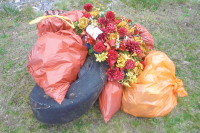Plugged in: Cherokee receives state’s first electric school bus
 Tribal officials and representatives stand around the new school bus with N.C. Gov. Roy Cooper and EPA Administrator Michael Regan. EBCI Communications photo
Tribal officials and representatives stand around the new school bus with N.C. Gov. Roy Cooper and EPA Administrator Michael Regan. EBCI Communications photo
With just about 2 inches to spare on each side, an 81-seat electric school bus eased into The Cherokee Convention Center exhibit hall last week for a celebration commemorating a milestone for the Eastern Band of Cherokee Indians and both North Carolina. Cherokee is home to the first — and, for now, only — electric school bus in the state.
“Has anybody ever thought about how far we’ve come, to have an electric school bus?” Cherokee Boys Club General Manager Greg Owle said during the event March 15, as recorded by WLOS . “The Cherokee Boys Club Incorporated is excited to enter a new threshold of environmental technology that will reduce the carbon footprint in our beautiful mountains. The Cherokees have always tried to live at one with nature, and to protect what we have so generously been given.”
Constructed by High Point-based Thomas Built Buses , the new vehicle was purchased through grant funds from North Carolina’s Volkswagen Emissions Settlement — the state’s piece of a massive settlement between the U.S. Environmental Protection Agency and Volkswagen following allegations that the company equipped cars in model years 2009-2016 with computer software designed to cheat on federal emissions tests. The grant completely covered the $360,000 price tag for the bus as well as $45,000 for the charger.
Celebration in Cherokee
Nine other jurisdictions also received grant funding for bus purchases through the program, but Cherokee is the first to receive a vehicle. EBCI Air Quality Program Supervisor Katie Tiger, who spearheaded the tribe’s application, credits the Cherokee Boys Club’s existing relationship with Thomas Built Buses and specifically Service Manager Donnie Owl for that outcome. The Cherokee Boys Club, which operates buses for Cherokee Central Schools, is certified to work on the company’s diesel buses and will soon be adding electric bus maintenance to its repertoire.
“We were ready for it,” she said. “As soon as we got notification, Donnie was on it.”
The March 15 celebration drew dignitaries from tribal, state and federal government to participate, including Gov. Roy Cooper and EPA Administrator Michael Regan, who formerly served as secretary of the N.C. Department of Environmental Quality.
Related Items
“These electric buses are better for the environment, better for children’s health,” said Cooper. “They cost less to maintain over time, and they are built right here in North Carolina by North Carolinians in good-paying jobs. That is a win-win-win-win for us today.”
Electric school buses cost about four times as much as conventional diesel school buses, said Tiger, but over time the cost is roughly the same due to lower fueling costs and simpler maintenance. Diesel buses have about 26,000 moving parts, while an electric bus has 26, so maintenance is easier.
Because they’re charged through the electric grid, their cleanliness depends on what’s powering the plug. In Western North Carolina, most areas are powered through Duke Energy, and most of Duke’s power comes from the power plant in Asheville, which in recent years has switched from coal to natural gas. According to the company’s website , the switch was expected to drop carbon dioxide emissions by about 60% per megawatt-hour, sulfur dioxide by 99% and nitrogen oxides by 40%, and to eliminate mercury.
“The bigger picture is these kids riding the diesel bus and they’re not having to directly breathe in those emissions,” said Tiger. “So locally, it’s better for the environment.”
In his March 15 address, Cooper gave an overview of North Carolina’s remarkable progress on air quality over the last few decades. Back in the 1980s and 1990s, pollution was terrible in Western North Carolina, on most summer days obscuring the long-range views that today are the region’s calling card. In 2002, the N.C. General Assembly passed the Clean Smokestack Act to reduce emissions at power plants in North Carolina, and Cooper, who at the time was the state’s attorney general, launched a legal battle against the Tennessee Valley Authority to force them to reduce pollution coming from out of state. Since becoming governor, Cooper has issued a series of executive orders to move the state even closer toward clean and renewable energy sources. In October, Cooper signed a bipartisan law that aims for carbon neutrality by 2050.
“It’s time to tackle clean transportation,” he said.

Principal Chief Richard Sneed signs a certificate commemorating the event, joined by Regan (left) and Cooper. EBCI Communications photo
First of many
Cherokee’s new bus is just the first of what tribal leaders hope to be many electric vehicles in the tribal fleet. The EBCI logged another first when it became the first tribe east of the Mississippi River to receive a Diesel Emissions Reduction Act grant from the EPA, which will allow it to purchase four more buses. The vehicles have already been ordered, and Tiger expects them to arrive this summer. The fleet of five will become a pilot project for the tribe.
“Really, these buses haven’t been tested in our area, so we wanted to test them in the mountainous terrain,” Tiger said. “I think they say 150 miles they can go on a charge in the flat land, and they’re estimating about 130 around here, but we’re going to see if that’s right.”
While the Volkswagen grant covered the entire cost of the bus purchase, the DERA grant requires a partnership. The EPA funding will cover $500,000, and Duke Energy is supplying an additional $860,000. The tribe will contribute $300,000 and the Cherokee Boys Club $60,000. Conditions of the state and federal grants require the tribe to destroy four diesel buses in exchange for the five it will receive through DERA and Volkswagen funding.
“A clean energy transition for our state is incomplete if we don’t also tackle transportation,” Stephen De May, N.C. president for Duke Energy, told the crowd March 15. “Transportation is the state’s largest source of greenhouse gas emissions. Duke Energy supports the governor’s Executive Order 246 to increase EVs and EV infrastructure. Duke realizes that it has a role to play in its success. That role focuses on access and affordability for all.”
Every day, said Regan, 5 million children ride a school bus. He hopes zero-emission buses become “the American standard.” An additional $17 million in clean school bus grants are soon coming to school districts across the country, he said, including $7 million from the American Rescue Plan. An “unprecedented” $5 billion is on the way for low and zero-emissions school buses from Infrastructure Act funding.
“The actions we all take today will determine the quality of life for our future generations,” Regan said. “I’m so optimistic about what lies ahead, and now it’s time for all of us to hit that accelerator.”
Ongoing efforts
The school bus project fits neatly with the tribe’s continued focus on environmental sustainability, evidenced through the October 2021 passage of a resolution committing to a drastic reduction in carbon emissions.
Under the resolution, the tribe will aim to buy at least 50% electric or hybrid vehicles when making new tribal fleet purchases and install 20 electric vehicle charging stations on the Qualla Boundary and at tribal buildings by 2024. Additionally, the resolution commits the tribe to paying for two staff members to become certified mechanics in electric and hybrid vehicles, and to assess opportunities for energy efficiency and renewable energy when planning new construction projects.
In the five months since the resolution passed, the tribal fleet has added two new electric vehicles to its ranks — a departmental transport vehicle and a forklift — said Secretary of Natural Resources and Agriculture Joey Owle, who championed the carbon reduction resolution. The tribe is also evaluating the potential for micro hydroelectric systems at two in-process projects, reconstructing the tribal fish hatchery and a restoring a stream in Big Cove. Additionally, the Cherokee Indian Hospital is applying for grant funding to install a solar array there, Owle said.
“The tribe’s really trying to be at the forefront of implementing the future of technologies that are available to us to reduce our emissions and increase our renewable energy production,” Owle said. “And so I just look forward to working with our tribal partners to help make all that possible.”













